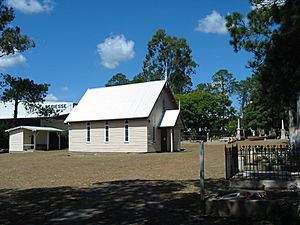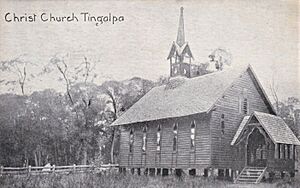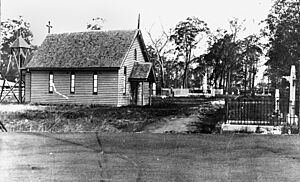Christ Church, Tingalpa facts for kids
Quick facts for kids Christ Church, Tingalpa |
|
|---|---|

Christ Church, Tingalpa, 2005
|
|
| Location | 1341 Wynnum Road, Tingalpa, City of Brisbane, Queensland, Australia |
| Design period | 1840s - 1860s (mid-19th century) |
| Built | 1868 - 1993 |
| Official name: Christ Church Tingalpa and Burial Ground | |
| Type | state heritage (built) |
| Designated | 2 February 1998 |
| Reference no. | 601799 |
| Significant period | 1868-1993 (fabric, and historical cemetery use) 1886- c. 1996 (historical, use of current church) |
| Significant components | headstone, grave surrounds/railings, church, trees/plantings, burial/grave |
| Lua error in Module:Location_map at line 420: attempt to index field 'wikibase' (a nil value). | |
Christ Church Tingalpa and Burial Ground is a historic former church located at 1341 Wynnum Road in Tingalpa, City of Brisbane, Queensland, Australia. It was built between 1868 and 1993. Today, it is known as the Pioneer Wedding Chapel. This important site was added to the Queensland Heritage Register on February 2, 1998.
Contents
History of Christ Church Tingalpa
The current Christ Church Tingalpa was built in 1886 for the Anglican community in Tingalpa. It replaced an earlier church from 1868. The first church was designed by Brisbane architect Richard George Suter. Sadly, it was destroyed during a powerful cyclone on December 5, 1885. It is believed that parts of the old church were used to build the second, smaller one.
The First Church and Its Importance
The original Christ Church was built and officially opened in 1868. It was the very first Anglican Church built between Kangaroo Point and Moreton Bay. This means it was built before other churches in nearby areas like Cleveland (1873–74) and Bulimba (1888).
The land for the church was given by Joseph Berry in 1868. It was a good spot on high ground, facing the road to Lytton (now Wynnum Road). This location was perfect because it was central to the small farming communities in the Bulimba-Tingalpa area. Local people helped clear the land and raised money to build the church.
The church was paid off quickly after it was finished. This made it one of the first Anglican churches in the Brisbane area to be officially opened. Many important people attended the opening ceremony on October 27, 1868. These included the Governor of Queensland, Colonel Samuel Blackall, and the Mayor of Brisbane, Alderman John Hardgrave.
The Burial Ground
A small burial ground was also created on the church land. The first person buried there was Susannah Weedon on July 12, 1868, even before the church was fully built. Many early farming families from the Tingalpa-Wynnum area are buried here. Important people like the Hon. William Duckett White, a member of the Queensland Parliament, and Richard Thomas Jefferies, who started the Queensland Musical Union, are also buried in this cemetery. The most recent burial happened in 1993.
Rebuilding After the Cyclone
After the cyclone destroyed the first church in 1885, the local Anglican community decided to rebuild. They used wood salvaged from the old building. The second Christ Church Tingalpa was officially opened on July 25, 1886. It was smaller and simpler than the first church. This time, a concrete floor was added to make the building stronger against strong winds.
In the late 1800s, areas like Bulimba and Wynnum grew a lot. By the mid-1890s, the Tingalpa church was no longer the main church for the area. Other churches like St Peter's in Wynnum (built 1898) became more important.
The Order of Witness and Later Years
In 1923, Christ Church Tingalpa became special. It was taken care of by a group called the Order of Witness. This was a unique group of priests who lived simply and helped people in remote areas, like mining camps. The farmhouse next to the church became their home, and the church became their chapel. They worked to restore the church and cemetery.
However, by the late 1920s, the Order of Witness moved on. The church once again started to fall apart. In the mid-1930s, there was even talk of tearing it down.
Saving the Church
Luckily, an enthusiastic local priest, Rev. EJV Cavey, saved the church in 1938. He organized a loan to fix it up. The old shingled roof was replaced with corrugated iron. The concrete floor was replaced with a new hardwood floor. A new bell tower was also built. The church was officially reopened on April 30, 1939.
After World War II, the Tingalpa area grew rapidly. More houses and businesses were built. In the 1950s, the church was painted and updated. In 1964, a church hall was added. By 1968, when the church celebrated its 100th birthday, its future looked bright.
However, in the 1990s, the church faced problems again. There was another call to demolish it. The bell tower was removed, and all the things inside the church were taken out. But the church was saved and restored by a group called The Friends of Tingalpa Cemetery Heritage Group Inc. Today, it is known as the "Pioneer Wedding Chapel" and is used for weddings.
What Christ Church Tingalpa Looks Like
Christ Church Tingalpa is a small, one-story timber building. It is set back from busy Wynnum Road in Tingalpa, on a raised piece of land. The church faces a main road, with businesses around it.
Building Design
The church has a high, pointed roof covered with corrugated iron. The outside walls are made of weatherboard, sitting on a concrete base. The building has a simple rectangular shape. At the eastern end, there is a small area called a chancel. To the south of the chancel is a small room called a vestry, which can be entered from inside the church or from outside.
A small entrance porch is in the middle of the western side of the building. Above this is a pointed arch with wooden slats. There are decorative wooden pieces at the ends of the main roof and the porch roof. A wooden cross is at the eastern end of the main roof. The main entrance has double wooden doors with a pointed arch shape. These doors are next to windows with three panes of patterned glass. There are three similar windows on each of the longer sides of the church.
Inside, most of the walls and ceilings are covered with fibrous cement sheets and wooden strips. The chancel walls are made of vertical wooden boards. A hardwood floor has been placed over the original concrete floor. None of the original church furniture or decorations remain inside.
The Burial Ground
The site also includes a burial ground, with most graves located to the west and south of the church. All the graves face east or southeast. The oldest headstone is from 1868, and the newest is from 1993. Some of the older graves still have their beautiful wrought iron fences around them. There are many different types of monuments and headstones from various time periods. Some parts of the ground are uneven, which suggests there are also unmarked graves.
Large trees, mostly Norfolk Island pines, surround the site. At the front northeast corner, two large fig trees seem to mark the original entrance to the grounds.
Why Christ Church Tingalpa is Important
Christ Church Tingalpa and its Burial Ground were listed on the Queensland Heritage Register on February 2, 1998, because they meet several important criteria.
Showing Queensland's History
This place helps us understand how Queensland's history unfolded, especially the development of the Tingalpa-Wynnum area from the mid-1800s. It shows how early settlers wanted to bring their culture and religion to Queensland. It is also one of the earliest Anglican churches in Queensland to be officially opened.
Rare and Special Heritage
The burial ground is very special because it is so old. It was created before many of the larger public cemeteries in Brisbane, like Toowong Cemetery, were established in the 1870s. It is rare because it is one of only a few Anglican church burial grounds still existing in Brisbane.
Learning About the Past
This site can help us learn more about how Tingalpa and nearby areas were settled long ago. It can also give us information about what life was like for people in those early days.
Good Example of a Historic Place
With headstones from 1868 to 1993, the burial ground shows many different styles of monuments from various periods. It is a good example of a small church cemetery that was started in what was once a rural area.
The church building itself, despite some damage, is a good example of a simple, rectangular, wooden Queensland church. It still has some decorative parts from the first architect-designed building, like the special window designs and the pointed arched entrance doors.
Beautiful and Important to the Area
The church has a lovely setting with tall trees around it. Some of the older graves still have their elegant wrought iron fences. The whole site adds a lot to the beauty of the Tingalpa area.
Special Connection to the Community
Both the church and the burial ground are very important to the local community. Many generations of families from Tingalpa and the surrounding area have worshipped and been buried here. It has been a center for Anglican worship and education since 1868.
Connection to Important People and Groups
The place is connected to the early settler families of the district, such as the Weedon, Coxen, Stanton, and White families. It is also important for its connection in the 1920s to the work of the experimental Order of Witness in Queensland.




